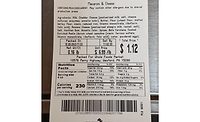It is obvious that many retailers are struggling during the economic downturn and are trying to find ways to maintain or grow food sales. Many food retailers have cut their gross profit margins or reduced prices of staple items in order to be more competitive in today’s marketplace. Labor has been hit the hardest because it is a direct expense. By reducing labor costs, the bottom line is directly impacted in a positive direction. Many companies have avoided hiring; instead, they are giving additional tasks to current employees. Other companies have laid off employees, cut back on hours or are only hiring part-time workers.
Over the last few years, there has been a significant increase in the number of families in which both parents work outside the home, leaving little time to make dinner and making sitting down for a family meal an ever-more-rare occurrence. The Food Marketing Institute’s (FMI) U.S. Grocery Shopper Trends 2009 report states, “The financially pinched consumer does not replace the time-starved consumer. Retailers have a great opportunity to win back mealtime.” This observation has given retailers a marketing strategy to pursue. Retail grocers’ ability to offer an array of prepared foods opens the door to additional center-of-the-plate sales, tie-in sales of complementary items and, ultimately, an increase in gross profits.
When looking at the two trends and their relationship to each other, we can surmise that retailers are looking for opportunities to maintain and grow their customer base, and parents are searching for ways to achieve a balance between making time for a home-cooked meal and finding someone else to provide a similar meal that fits within the family budget.
While dealing with reduced labor and, simultaneously, the expectation to become more efficient and productive, retailers are concerned about preparing food safely. It is imperative that their employees use food safety processes and procedures accurately, without taking shortcuts. For consumers, the struggle is to obtain the necessary groceries and staples to maintain a healthy lifestyle while staying within their budget. Consumers want high-quality, wholesome prepared meals; they do not want to wonder whetherthe safety of that food has been compromised.
Many studies speak to the issue of consumer attitudes. Confidence in food safety at retail and in the food industry overall has been slipping. Consumers are becoming more aware of all the recalls, due in large part to media coverage, access to the Internet, smart phones that provide instant alerts and the U.S. Food and Drug Administration’s (FDA’s) stronger focus on consumer information that people can access via the FDA’s Web site.
The larger retail chains have food safety specialists and good training programs in-house to ensure food safety throughout the operation. Today, this is a matter of necessity because of the potential negative impact that a foodborne illness would impose upon the business. Smaller operators—those that have three or four units—know about food safety and may have someone in a specialist oversight position. Other small establishments may understand most of the concepts, but may not have the time or money to put one person in charge of overseeing food safety in their organization. Consumers are confident that supermarkets will deliver safe food, but this is only one segment of the marketplace where you can obtain food. The focus needs to be on ALL retail establishments with the understanding that problems exist, issues should be resolved through training, and companies must find a way to have a designated person monitor food safety throughout the supply chain.
But the big question is: how? How can food safety be instilled in employees? How are establishments held accountable? How can an establishment be proactive and prevent incidents, rather than being reactive when an outbreak occurs? Following Hazard Analysis and Critical Control Points (HACCP) guidelines may be one way, but few states require HACCP plans to be implemented. Prepared foods at retail would be safer with HACCP, but this process will not occur without both regulation and training.
Prepared Foods Safety
The prepared foods case is just one area that has its own safety issues. Ready-to-eat food has been processed in some form and put together to make it easy to eat. Examples are hot rotisserie chickens, sandwiches, wraps, cut-up fruit and vegetables, in-house-made salsa, leafy green salads, seafood salad, broccoli salad, fried chicken and chicken tenders. These foods need to have the proper protection from cross-contamination as there is not another processing step.
Another type of prepared food is the ready-to-cook foods, such as stuffed pork chops, stuffed sirloin roast, fresh chicken cordon bleu and other varieties of raw, stuffed chicken breasts, which have a different set of issues. Many consumers judge cooking time by how the food looks and do not use a thermometer to test the internal temperature. Thus, for ready-to-cook products, labeling is extremely important; it should include complete cooking instructions. If the label does not provide the necessary information, consumers will guess about how to cook the food. If the front-line workers are not sufficiently knowledgeable about food safety, the consumer will have even less knowledge. One way to protect the consumer is to require instructions with cooking temperature information on all ready-to-cook foods that are prepared in retail operations. At this time, the only regulatory requirements are to list allergen and ingredient information for self-serve proudcts.
Retailers have considerable control over many food safety challenges. Foodborne illness should be exceedingly rare from prepared foods in retail, but the reality is that even the best operations rarely achieve a perfect record; there is always potential for human error. The key to making progress on these issues is to ensure that training gets to the source of most contamination problems: the employees. The level of expectation that management sets forth is exactly what they will get. If you expect high food safety standards and only accept that level, you will have a safer operation. When inspections are poor, management expectations are likely poor. This is evident when retailers have repeat violations, and efforts must be taken by local or state inspectors to force corrective action.
Personal Hygiene/Cross-Contamination
Personal hygiene is a continuous challenge in retail. Up to 25% of inspections find an issue with employees not washing their hands or having enough sinks available. A foodborne illness outbreak in 2008 caused at least 125 persons to contract Staphylococcus due to improperly washed hands and subsequent touching of the food. This event occurred because the food became contaminated with bacteria from the unwashed hands, and, although the food was cooked, the bacteria survived.
Even with all of the inspection reports, studies, publications and training, personal hygiene remains a problem. Is it due to a lack of information or are there other factors? How many companies actually have a personal hygiene policy in writing and then enforce it? My teaching experience has validated this concern; it is rare to find a company, other than a chain, that does this. Shouldn’t a food safety philosophy start from the top down? If so, then the owner or general manager is responsible for the food safety practice of the entire operation.
When I cover the Exclude and Restrict portion of the Food Code in food safety certification classes, I find that the majority of people in the class have never heard about this. Many times, management understands that someone should not work when they are sick, but because staffs are so lean, most managers will allow ill employees to work anyway, stating that they will be especially careful. The FDA outlines employee and management responsibilities on their Web site, but clearly, the message is not getting out. To protect the health of consumers and their own businesses, it is imperative that retail managers who are not already familiar with FDA’s guidelines seek out that information.
Cleaning and Sanitizing
Up to 58% of inspections find procedural issues with cleaning and sanitizing. Some problem areas are the preparation tables, cutting boards, slicers and mixers. If you ask several workers the definition of cleaning or sanitizing, you get many different answers. Some employees have even been told to sanitize without cleaning first to save time. There is a huge misunderstanding of the cleaning and sanitizing process, including how and why it should be done in a particular fashion. The thought is, “at least we are sanitizing.” Both management and staff need to be trained in how a sanitizer works.
When it comes to floor drains and the use of hoses to “clean” them, the majority of students do not realize that cross-contamination can result from spraying water on a bacteria-laden floor drain. An Ecolab study showed that about 50% of drains tested had one to two log10 colony-forming units (CFUs), while aerobic plate counts showed total levels of four to eight log10 CFUs.
Those of us who train retail employees in food safety and sanitation are responsible for teaching proper practices and emphasizing their importance on a daily basis. Unfortunately, we cannot follow up and ensure that employees are doing the best job possible—this is the responsibility of the management.
Improper Holding/Time and Temperature
Studies have shown that almost 30% of retail inspections find improper holding times or holding temperatures, refrigeration that is broken or old refrigeration that was designed when the maximum cold holding temperature was 45 °F. Equipment can be readjusted for temperature, depending on the type of case, for a minimal cost. However, other cases may need to be replaced at a greater expense.
Other concerns are the lack of knowledge about cooling paddles, the lack of desire to spend the money to purchase these items, and mass storage of product that should have been broken down into smaller portions to allow more surface area to disperse the heat. Inspections have also found large quantities of food raising the temperature of other products above or around the food that is being cooled.
While shopping, have you ever seen condensation on the lid of what was supposed to be a properly cooled food? That is a sure sign that the food was too hot when it was packaged? It is surprising that we do not have more outbreaks. In 2007, Clostridium perfringens affected 126 inmates that was believed to be caused by improper reheating and holding of the food served. The two major reasons given for not following prescribed cooling methods were “employee turnover” and “the staff was too busy to do it correctly.” Some retail managers also state it takes too much time or is too expensive to train workers. FMI has a 45-minute DVD called “The Invisible Challenge” that covers the basics of food safety. The areas covered are Personal Health and Hygiene, Proper Temperature and Time Control, Prevention of Cross-Contamination and Food Allergen Control and Awareness, as featured in the 2009 FDA Food Code. This provides an inexpensive, easy way for employees to access training. Employees can watch the DVD, and learning can be verified by using questionnaires provided with the DVD. On-the-job training can continue from there, and the business will benefit from the employees’ increased awareness of food safety principles.
Food safety must be an integral part of day-to-day operations. It does take time to set up a program, but companies that have had to begin from scratch and build a full program have found that they are able to reap enormous benefits. Focusing on food safety will increase the quality of the products you serve and help to maximize your inventory dollars. Customers will notice the difference, giving you an opportunity to increase the bottom line. Just remember that staff training must be ongoing: It only takes one person not following food safety guidelines to trigger an outbreak of foodborne illness.
Employee Training
While I was researching material for this article, Pennsylvania State University Co-operative Extension food safety classes were in session. Instructors handed out a general survey at the end of the class. This survey helps to evaluate teaching quality, what students found important and relevant to their particular retail facility, which tasks were usually performed at their specific facility, what has been an area of increased awareness and what has not been part of the normal tasks performed at their facility but will now be implemented due to their additional knowledge and understanding of food safety. The top three areas noted for improvement were Personal Hygiene, Cleaning and Sanitizing and Time/Temperature (TCS).
The goal of each class is not only to provide instruction for the national test but to impress upon each student to take the information they have learned and teach others in their organization about the basics of food safety. The majority of students in this class are owners, managers, chefs, prep-cooks, mobile cart vendors, caterers and persons wanting to start a new retail food facility.
However, there is a critical need for training of front-line employees who handle the food, cool the food and perform all of the other tasks needed to ensure safe product. The information conveyed in classes such as those described above must flow to all of the employees who handle food. College extension offices in various parts of the country do just that by reaching out to organizations that want help and training to serve the public safely. Penn State offers a “Cooking for Crowds” program to groups that prepare and serve food at churches, fire halls and other casual settings. Other commonly available food safety training and certification programs include the National Restaurant Association’s SERVSAFE™ program and FMI’s SuperSafeMark™ program. Numerous resources are easy to take advantage of—if management truly desires to provide safe food.
Even with all the resources available, we see repeat violations and careless outbreaks in retail far too often. Annex 7 of the FDA Food Code speaks directly to the employee, but the management is held accountable for getting the proper information to employees. Forms 1-A and 1-B are not discussed in the training programs for food safety certification. Would this be a good place to set the stage for a company that is serious about food safety? Every employee should get these forms. In Form 1-B, point number three is paraphrased as, “I understand my responsibility to comply with good hygienic practices and if I do not comply it could jeopardize my employment and may involve legal action against me.” Do you think this would set expectations for the priority given to food safety in an establishment?
Conclusions
Visiting retail establishments, observing numerous food production operations, performing inspections and training will give a person a broad perspective as to the reality of how food safety processes are implemented and to the level of commitment (or lack thereof) to food safety. Establishments that are committed strive to excel and meet the challenges they are faced with daily. Establishments that lack commitment wait until they get caught.
The solution is to bring food safety into each establishment, not for the sole purpose of passing an examination, but to have the students understand the importance of what is being taught. Education is first. The students need to have the desire to learn, take the training back with them and actually implement Sanitation Standard Operating Procedures. There is a way to make changes and to get food safety consciousness to penetrate the minds of workers. Regulations can force this to occur by empowering inspectors to ensure that regulations are being followed; these inspections must be consistent and enforced without politics. Experts can provide input on best practices using strong science-based data, and trainers can instruct employees and be there to guide them through process implementation so that they can be successful. All of these changes must occur to achieve the ultimate goal—safe prepared foods for the public.
Barry E. Parsons is a Facility Management Professional and the General Manager and Food Safety Coordinator of Stauffers of Kissel Hill. He is a Servsafe-certified instructor at Penn State Co-operative Extension and is the Food Safety and Food Production Specialist of Robson Forensic. He can be reached at bparsons5@verizon.net.
Sources
1. www.fmi.org.
2. www.fda.gov/Food/FoodSafety/RetailFoodProtection/FoodborneIllnessandRiskFactorReduction/RetailFoodRiskFactorstudies/ucm089696.htm.
3. www.fda.gov/Food/FoodSafety/RetailFoodProtection/IndustryandRegulatoryAssistanceandTrainingResources/ucm184170.htm.




